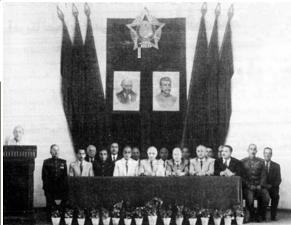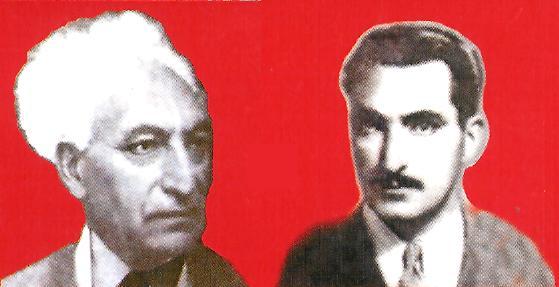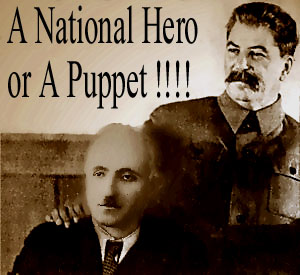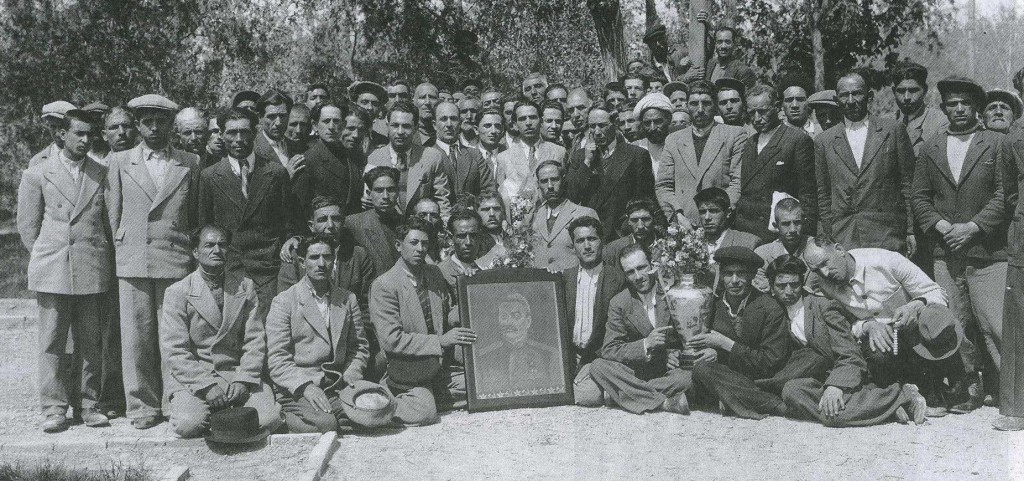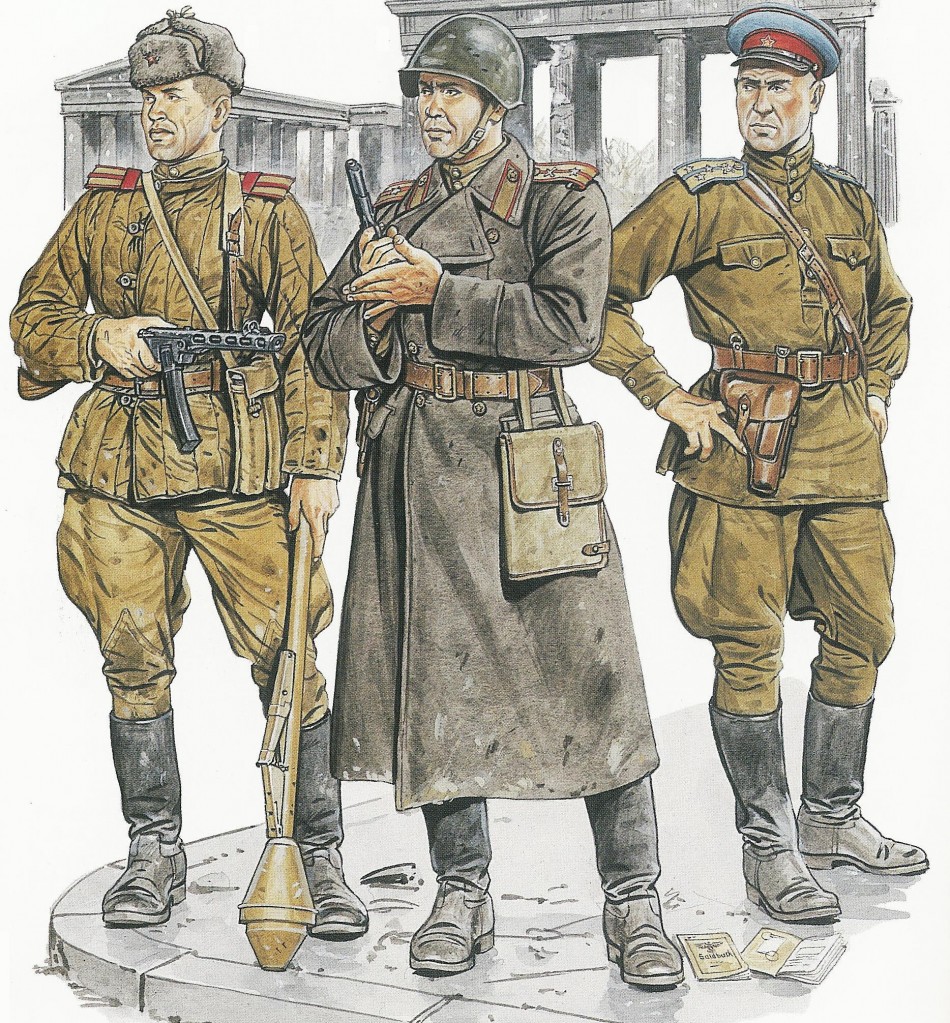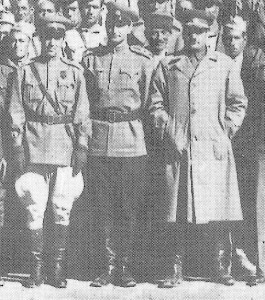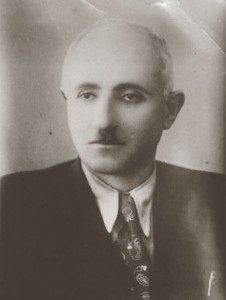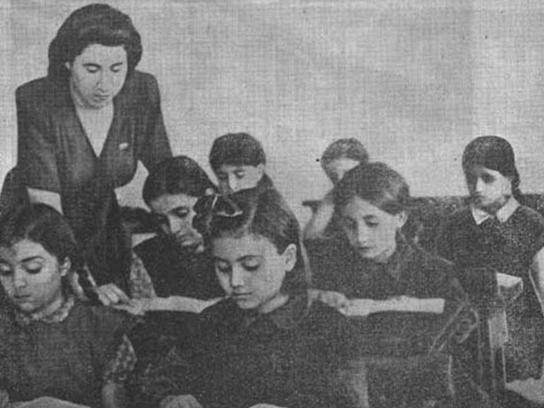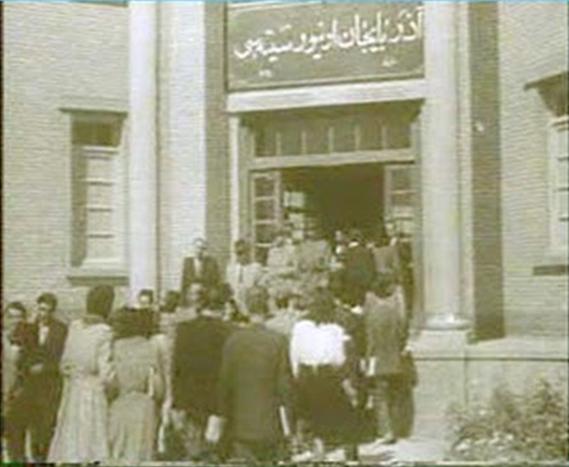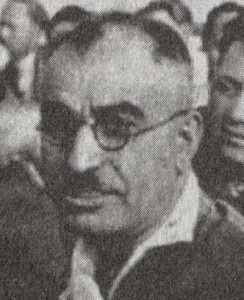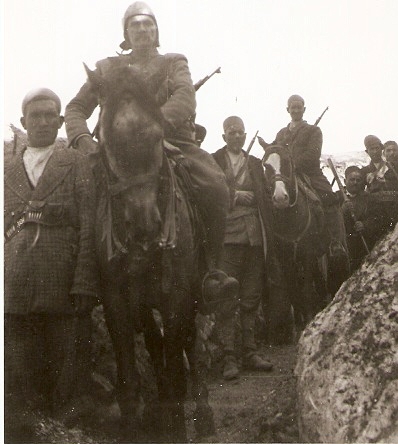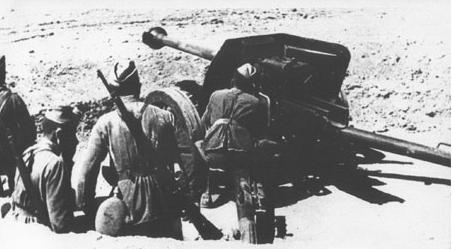Question 5: Was the Ferqeh Democrat and Seyed Jaafar Pishevari’s movement in 1946 in this Kaveh Farrokh: Let us first clarify the term “Democrat”. The Pishevari regime was anything but “Democratic” and pluralist. This was a puppet and racist regime taking its orders from Moscow and Baku. There is very little doubt about this especially if we look at the historical sources. A photo op of Seyyed Jaafar Pishevari’s Russo- Soviet controlled separatist administration. Despite the photo’s poor quality, the portraits of Russian Communist leaders Vladimir Lenin (with bald pate) and Joseph Stalin are clearly displayed. Note the five-pointed Communist star above the portraits. The Communists and their local “Democrat” derivatives in Azarbaijan were vehemently against Iranian history and the Persian language. They were also under the direct control of Moscow and Baku. Nosratollah Jahanshahlu-Afshar who was a member of the Pishevari cabinet, reports that the local Communist Party or Tudeh forced workers to wear Communist regalia with portraits of Soviet leaders such as Stalin plastered on Tabriz’s government buildings. Jahanshahlu-Afshar noted that the local Communists and Democrats “…forced workers to wear belts with buckles gearing the hammer and sickle motif…slogans were overtly Communist and even separatist…” (2006, pp.97) and that “…the walls and doors of the Workers Union building in Tabriz was plastered with portraits of Stalin, Bagherov and other leaders of the Bolshevik Party” (Jahanshahlu-Afshar, 2006, pp.151). Dr. Nosratollah Jahanshahlu-Afshar in his younger years (right) and today (left). As a former member of the Pishevari regime, Dr. Jahanshahlu-Afshar provides insight into the extent Pishevari was a puppet and instrument of the Communists of Moscow and Baku. He also details the racist Persophobic policies of the Pishevari regime and the Soviet role in promoting this. There were parallels between Pishevari’s government and those found in Soviet occupied Eastern Europe: many of the “government” appointees were self-serving opportunists who had hitched their fortunes to Moscow. Consult Jahanshahlu-Afshar (2006) with discussions with respect to Pishevari government officials such as Salamollah Javid in charge of the secret services (pp. 142-145), Gholam-Reza Elhami, a cabinet Minster (pp.147), Dr. Mehtash, Minister of Agriculture (pp.148), and Jaafar Kavian, Minster of War (pp.148-149). By December 1946 the Pishevari regime had became so dictatorial that listening to radio broadcasts from London or even Ankara risked the death penalty in Tabriz (Roosevelt, 1947, p.264). Who is the Boss? Photoshop image showing Pishevari with his ultimate master: Joseph Stalin (source: Buruk). A letter written by Stalin to Pishevari stated in no uncertain terms as to who was “the boss”. That letter is printed for reference below. ==================================================================== Stalin’s Letter to Pishevari dated May 8th, 1946 To comrade Pishevari, It seems to me that you misjudge the existing situation, inside Iran as well as in the international dimension. First, You wanted to meet all revolutionary demands of Azerbaijan right now. But the existing situation precludes realization of this program. Lenin used to put forth revolutionary demands as practical demands, as practical demands only when the country experienced a grave revolutionary crisis aggravated by the unsuccessful war with external enemy. Such was the case in 1905 during the unsuccessful war with Japan and in 1917 during the unsuccessful war with Germany. You here want to emulate Lenin. This is very good and laudable. However, the situation in Iran today is totally different. There is no profound revolutionary crisis in Iran. There are few workers in Iran and they are poorly organized. The Iranian peasantry still does not show any serious activism. Iran is not waging a war with external enemy that could weaken Iran’s revolutionary circles through a military failure. Consequently, there is no such situation in Iran that could support the tactics of Lenin in 1905 and 1917. Second, Certainly, you could have counted on a success in the cause of the struggle for the revolutionary demands of the Azerbaijani people had the Soviet troops continued to remain in Iran. But we could no longer keep them in Iran, mainly because the presence of Soviet troops in Iran undercut the foundation of our liberationist policies in Europe and Asia. The British and Americans said to us that if Soviet troops could stay in Iran, then why could not British troops stay in Egypt, Syria, Indonesia, Greece, and also the American troops – in China, Iceland, in Denmark. Therefore we decided to withdraw troops from Iran and China, in order to seize this tool from the hands of the British and Americans, to unleash the liberation movement in the colonies and thereby to render our liberationist policy more justified and efficient. You as a revolutionary will certainly understand that we could not have done otherwise. Third, All this said, one can come to the following conclusion with regard to the situation in Iran. There is no profound revolutionary crisis in Iran. There is no state of war in Iran with external enemies, and, consequently, no military failures which could weaken the reaction and aggravate the crisis. So long as Soviet troops stayed in Iran, you had a chance to unfold the struggle in Azerbaijan and organize a broad democratic movement with far-reaching demands. But our troops had to leave and left Iran. What do have now in Iran? We have a conflict of the government of Qavam with the Anglophile circles in Iran who represent the most reactionary elements of Iran. As reactionary as Qavam used to be in the past, now he must, in the interests of self-defense and the defense of his government, carry out some democratic reforms and seek support among democratic elements in Iran. What must be our tactics under these conditions? I believe we should use this conflict to wrench concession from Qavam, to give him support, to isolate the Anglophiles, thus, and to create some basis for the further democratization of Iran. From this assumption stems all our advice to you. Of course, one could adopt a different tactic: to spit on everything, to break with Qavam and thereby ensure there a victory of the Anglophile reactionaries. Yet, this would not have been a tactic, but stupidity. This would have been in effect a betrayal of the cause of the Azerbaijani people and Iranian democracy. Forth, You, as I found out, say that we first raised you to the skies and then let you down into the precipice and disgraced you. If this is true, it surprises us. What has really happened? We used the technique here that every revolutionary knows. In the situation similar to the situation of Iran today, if one wants to achieve a certain minimum of demands pursued by the movement, to movement has to run ahead, to progress beyond the minimal demands and to create a threat for the government, to ensure a possibility of concessions on the part of the government. Had you not run far ahead, you would not have had a chance in the current situation in Iran to achieve these demands “ concessions” that the government of Qavam has to make now. Such is the law of revolutionary movement. There could not be even mention of any disgrace for you. It is very strange that you think that we could have let you down in disgrace. On the contrary, if you behave reasonably and seek with our moral support the demands that would legalize essentially the existing factual position of Azerbaijan, then you would be blessed both by the Azeris and by Iran as a pioneer of the progressive democratic movement in the Middle East. J. Stalin =================================================================== Note a rare picture of the Ferqeh Democrat separatist organization which poses Soviet Communist leader Joseph Stalin: [CLICK TO ENLARGE] Ferqeh Democrat poses with a portrait of Joseph Stalin in 1946. Stalin’s tanks and troops had entered Iran by military force and was occupying the country. This photo is remarkable as it shows that the Ferqeh Democrat was beholden to its masters in Moscow and Baku. Many of these men were not even Iranian citizens – these had been bussed in from the Soviet Union by the Soviet army to act as controllers and spies inside Iran on behalf of the Soviets (see Iran at War, 2011, pp. 285-286, 290-292), Professor Majid Tafreshi also reveals documents that Pishevari was a puppet of Stalin in the video below: Majid Tafreshi discusses factors leading to Anglo-Russian invasion of Iran in August 1941 and the role of the Soviets in promoting the separatist movement. As in the occupying Red Army, political officers (thirty in total) who were mostly from the Soviet Union, provided the link between Pishevari’s army and his party (see Ramazani, 1971, p.413; Pesyan, 1948-1949, pp.126-148). All movements, appointments and activities of Pishevari’s government were closely monitored and supervised by the leader of the Baku Communists, Mir Jaafar Bagherov (1896-1956) who provided daily updates to Stalin and other high-ranking Soviet officials (Leffler & Painter, 2005, p.102). All of this explains why Ward has recently noted that the Pishevari regime: “…quickly became an unpopular police state dependent on the Soviet Union for its survival” (Ward, 2009, pp.182). Just months after the declaration of the Pishevari regime, an underground Azari army soon emerged to fight it, a fact confirmed by the New York Times in early January 1946 – the article for those who are interested is: “Underground army in Azerbaijan Fights Autonomous regime, Official Says”, New York Times, January 9, 1946. As events were to soon prove, the real military muscle behind Pishevari’s survival was the Red Army. Reconstruction of Russian officers in Berlin in 1945 [left] and the “Azerbaijan Feda-iyan” [right] – note Gholam Yahya Daneshiyan standing at the right. The similarity of the uniforms of Pishevari’s troops with those of his Soviet supporters are striking. Despite the photo’s poor quality, Daneshiyan’s uniform is that of a Junior Lieutenant of the Russian Red Army; the two men standing next to him wear the uniforms and caps of Soviet NKVD officers (Red Army political/intelligence officers). The Red Army was the main force behind Pishevari’s puppet regime. This brings us to the next point as to whether the Pishevari movement was pan-Turkist. Supporters of the Pishevari regime today, both pan-Turks and their western advocates, tend to downplay the role of the Soviet Union and of course deny any pan-Turk connections. But the reality was different. As we shall soon see in our unfolding discussion, the Pishevari regime was a racialist regime operating under the Soviet Communist banner. Seyed Jaafar Pishevari (1893-1947). Dr. Jahanshahlu-Afshar’s memoirs make clear that when Pishevari escaped to the Soviet Union he openly admitted that his major error was in trying to cut the ties of Azarbaijan from Iran. These sentiments earned the wrath of Mir Jaafar Bagherov, the leader of the Baku Communists. There are now questions as to whether Pishevari’s death in Baku may have been engineered by the Communists, increasingly embarrassed at their protégés sentiments. Fundamental to the Democrats’ policy was ignoring the longevity of Azarbaijan’s cultural and historical links with Iran. “History” books were immediately produced under Soviet supervision which deliberately aimed at falsifying the past. A perfect example of such “textbooks” is the case of the Vatan Dili (Language of the motherland) which narrated a Soviet version of Azarbaijan’s history without making references to the area’s deep-rooted Iranian legacy. For more on this subject see Atabaki (2000, pp.167, footnote 127 on pp.226). Soviet indoctrination techniques for children applied to ingrain pan-Turkist philosophy. A version of the Soviet-sponsored Vatan Dili textbook was being taught to Iranian Azerbaijani children during the armed Soviet occupation of northwest Iran. The book was essentially another product of Soviet history-falsification schemes meant to promote Stalinist imperialism. Stalin, like his Czarist predecessors, coveted Iranian territory as far as and including the Persian Gulf. He also wanted to possess the bulk of the Iranian oil market which was mainly under British domination at the time. Propaganda movies falsifying history were also produced. The first significant cinema production in support of a mythical Greater Azerbaijan was produced in 1947, just after the fall of the “Democrats”. Bagherov officially inaugurated the first showing of the movie to the former cabinet members of the defeated Pishevari regime, now in exile in Baku. The movie was called “The Other Side of the Araxes”, meaning Iranian Azerbaijan. Footage for the film had been taken during the Russian and Communist occupation of Iranian territory. A Soviet propaganda film produced during the Soviet occupation of northern Iran. The movie was laden with historical fabrications and distortions and was aimed at creating ethnic strife inside Iran. Jahanshahlu who had attended the show (along with Pishevari shortly before his mysterious death) reported the following about the movie: Soviet propaganda Ministry or “University”? The occupying Soviet army ensured that a series of Moscow-Baku “educational” facilities were set up. The main objective of these was to stamp out the Persian language and culture in Azarbaijan as quickly as possible. The ultimate aim was to brainwash Iranian Azarbaijanis to disassociate themselves from Iran and to join the Soviet Union. Bagherov was an extreme Europhile and Russophile. He wrote in the February 1953 edition of the Russian newspaper Kommunist that the peoples living along the Caspian Coast wished: “…for nothing so much as the coming of the Muscovites as quickly as possible to deliver them from the yoke of Persian monarchy” (see Swietochowski, 1995, pp. 173-174). It would appear that Bagherov was either unaware of (or chose to ignore) the historical records testifying to the fierce resistance in the southern Caucasus against the Czarist conquests during the 19th century. Mir Jaafar Bagherov (1896-1956) had an intense dislike of Iranians and Persian culture. An extreme Europhile and Russophile, Bagherov is also the inventor of the term “Persian Chauvinism”. The term was invented by him and fellow Communists to create ethnic conflict inside Iran for the benefit of Soviet imperialism. Bagherov and his Communist comrades also used the term “pan-Iranist” against those who questioned Soviet falsification of Iran’s history and especially her legacy in the Caucasus. The fact that Bagherov’s movie was so divergent from historical reality did not matter to Stalin or the Communist elites. Here was yet another case of Soviet propaganda using books and media to falsify history to promote Russian imperialism. For more details on that Soviet revisionist movie consult Jahanshahlu-Afshar (2006, pp.205). Soviet authorities tried to fan hostility against the Persian language and encouraged Iranian Azarbaijanis to join the Soviet Republic of Azarbaijan (former Arran). Iranian Azarbaijanis however were unreceptive to the Pishevari regime’s increasingly pan-Turkist and anti-Persian “educational” policies. These policies also resulted in widespread apprehension within the province of being severed from Iran and attached to the Soviet Union. This is due to the fact that Iranian Azarbaijanis and Turkic-speakers in general have played a crucial role in Iranian history right up to and including the 20th century all the way into the present era. Iran’s highly influential Turkic-speaking Azarbaijani population remains deeply engaged in the nation’s political, educational, and economic life. Anti-Pishevari Iranian Azari fighters. These fought against the Soviets and their satellite regime in Iranian Azarbaijan (Picture source: Azarpadgan). Contrary to the propaganda of the current Baku establishment and pan-Turkists, the Soviet-controlled Pishevari regime was strongly opposed by the local population, especially in the latter days of his regime. But let us return once again to Bagherov’s extreme Russophilia. Bagherov had already expressed these sentiments in 1945 when Russian troops were inside Iran. As noted by Kolarz (1952, p.244) Bagherov had stated that: “…the Azerbaidzhani people are indebted to the beneficial influence of the great Russian scholars, teachers, poets, writers, artist, etc. We have learned from the Russian people…”. Bagherov’s Russophilia explains why he was so off the mark with how the Azarbaijani people of Iran felt towards Russia. It is amazing that Bagherov was unaware of Russia’s very low popularity in northern Iran (and Iran as a whole) as a consequence of the 19th century Qajar wars, the Czarist role in militarily suppressing the Iranian Constitutional Movement in the early 20th century and their 1941 invasion of Iran. It is as if all of this history had been erased from his mind. Bagherov is a tragic figure as he symbolizes the long-term effects of Russo-Soviet sponsored cultural engineering dating back to the 19th century. Another myth of the Pishevari era was that the economy of “Democrats” was booming and that the entire province was awash in prosperity. This is again based on Soviet propaganda – an examination of impartial historians shows a very different, if not grim, picture. The truth was that the Soviets had seized farmlands in northern Iran and Azarbaijan. These led to the forcible diversion of foodstuffs away from Iranian civilians in favor of the Soviet war effort. These actions resulted in severe economic hardships and food shortages in those areas under occupation. This may be partly explained by the fact that the Ukraine, known as the “breadbasket of the Soviet Union”, had been lost by the Soviets to the Nazis since September 1941. It is also a fact that many of the followers of the Pishevari movement who had fled to Baku became extremely disillusioned with the Communists and their separatist clients. Below is a 3-part video which outlines an Azarbaijani researcher, Mohammad Arasi, sheds light on the realities of Pan Turkism by discussing the Varliq magazine which is a mouthpiece of Baku and the discredited Pishevari movement. The following three videos are significant for the following reasons: 1- The first video from the same show describes the miserable fate of Iranian Pan-Turks when “Comrade Stalin” became became angered with them. They were barred from returning to Iran. They were also forced to live in misery and humiliation in Baku and other parts of former USSR. One of these was even forced to wash dead bodies in Baku! When he returned to Iran, he kissed Iran’s soil and said: “Azerbaijanis do not follow our path“! 2- Mohammad Arasi presents very clear evidences for the historical basis of the name Arran for lands across or north of the Araxes river. The sources originate from from classical Parsi literature. 3- These report on the actions of a Turkish-Persian magazine called Varliq which is in essence the “legal” source of Pan Turkism in Iran. Varliq hides its true intentions behind a mask of pan-Islamism while promoting hatred and division among the Iranian people. 4-Varliq twists the historical facts of Azarbaijan and Arran (modern Republic of Azarbaijan). They often re-write history by re-narrating Iranian-Azarbaijani national heroes such as Sattar Khan as the champions of separating Azarbaijan from Iran. They often twist and distort information of Iranian-Azarbaijani poets such as Shahryar by selectively translating his works into Turkish: they remove those parts where Shahyar expresses his longing and appreciation for Iran! This is to benefit of the ethno-nationalists of Baku just as all of this published perfectly legally in Iran. This has been happening for over three decades. 5- The authors of Varliq, including its chief editor Javad Hayat, live for the main part in Baku. 6- Some writings of Varliq (the fourth video) encourages Azarbaijanis to commit Genocide against Armenians. They often extol Timur e lang or Tamerlane as a hero even as he massacred countless Iranians, including Azarbaijanis. Timur has no historical connection to Azerbaijani nor are Armenians historical enemies of Iranian Azaris. Such narratives are based on Baku-based propaganda. Varliq works to promote fascism in Iran. -(محمد ارسی: نشریه پان ترکیستی وارلیق (1) – -Part 3-Mohammad Arasi: TV program Sarzamin e Javid hosted by Dr. Bahram Moshiri discussing the decrepit state of pan-Turks, especially after they fled to the Soviet Union in late 1946. -(محمد ارسی: نشریه پان ترکیستی وارلیق (2) – -Part 2-Mohammad Arasi: The Varliq pan-Turkist publication-محمد ارسی پژوهشگر آذربایجانی در رابطه با فصلنامه پان ترکیستی وارلیق به مدیریت جواد هیات در برنامه سرزمین جاوید مهندس بهرام مشیری افشاگری می کند-Iranian Azarbaijani researcher Mohammad Arasi discusses the pan-Turkist journal Varliq (editor: Javad Hayat) in the program Sarzamin e Javid hosted by Dr. Bahram Moshiri. -(محمد ارسی: نشریه پان ترکیستی وارلیق (3)-Part 3-Mohammad Arasi: The Varliq pan-Turkist publication-پان ترکیست های حمایت شده از سوی باکو سعی دارند با دروغ تاریخ ایران، آذربایجان و اران را بازنویسی کنند. آن ها هر یک آذربایجانی میهن دوستی از عشقش به ایران گفته آن بخش را در ترجمه های خود حذف می کنند و به این ترتیب در راستای منافع پان ترک ها از آذربایجان ایران زدایی و آذربایجان را در برابر ایران قرار دهند. به عنوان مثال ستارخان را قهرمان استقلال آذربایجان از ایران معرفی می کنند.-Pan-Turkists sponsored by Baku seek to re-write the history of Iran as a whole as well as azarbaijan and Arran (modern Republic of Azarbaijan). Pan-Turkists repeatedly erase the history of Azarbaijanis who fought for Iran in the endeavor to pit Azarbaijanis against the rest of Iran. One example of their historical falsifications is re-introducing Sattar Khan as a separatist who fought to detach Azarbaijan from Iran -نشریه وارلیق که بیشتر نویسندگان آن –از جمله خود جواد هیات- ساکن باکوست هیچ وقت از آذربایجان حمایت نکرد و بالعکس تخم نفرت قومی در منطقه می کارد.-The Varliq publication whose writers (including Javad Hayat) reside in Baku, do not defend Azarbaijan as much as they seek to create ethnic conflict inside Iran. -(محمد ارسی: نشریه پان ترکیستی وارلیق (4) -Part 4-Mohammad Arasi: The Varliq pan-Turkist publication-یکی از مطالب مهمی که در این برنامه از آن پرده برداشته می شود این است که نویسندگان نشریه وارلیق با کاشتن بذر نفرت علیه مردم ارمنستان مردم آذربایجان را تشویق به نسل کشی ارامنه می کند و خونخوارانی نذیر تیمور و آتیلا را که دستشان به خون مردم ایران هم آلوده است را پدران آذربایجانی ها معرفی کرده و از آنها می خواهد مانند این جنایتکاران –که در واقع ربطی هم به مردم آذربایجان ندارند- عمل نمایند. این نوشته علاوه بر تحریف تاریخ وجه خطرناک تری به نام فاشیسم دارد.-One pf Varliq’s tactics is to incite racial hatred against Armenians and to encourage their massacres. Varliq also introduces blood-thirsty conquerors such as Attila and Ghenighiz Khan (who conducted many massacres in Iran, inclusing Azarbaijan) as the ancestors of Azarbaijanis. Varliq now attempts to make Azarbaijanis identify with such figures despite the fact that this has little historical basis. Varliqs writings are as dangerous as they are fascist-این نشریه ضد ایرانی در حالی آزادانه در ایران منتشر می شود که جوانان میهن دوست حزب پان ایرانیست را که برای بررسی تحرکات اخیر تجزیه طلبان دور هم جمع می شوند را دستگیر می کنند.-Varliq is published freely in Iran while Iranians (including Azaris) who oppose pan-Turkism and racial conflict are often jailed by Iranian authorties (see report in Persian by clicking here). On this topic consult: “How are Iranians promoting Persophobia, pan-Turkism and Separatism“? As we noted before, the Pishevari regime and their Communist masters in Moscow and Baku were intensely disliked by the Azarbaijani population of Iran. Dr. Gary. R. Hess has noted the following on the collapse of the Pishevari regime: “On December 11, an Iranian force entered Tabriz and the Pishevari government quickly collapsed. Indeed the Iranians were enthusiastically welcomed by the people of Azerbaijan, who strongly preferred domination by Tehran rather than Moscow…” (See Hess, G.R., Political Science Quarterly, Vol. 89, No. 1, March., 1974). All of the facts we have discussed here are conveniently forgotten by contemporary pan-Turk revisionists and especially their supporters in the West and Baku. It is very tragic to see that this type of biased historical amnesia still pervades in much of modern-day Republic of Azarbaijan or Arran-Albania. Challenging another myth: Rare photo of the “Democrats” Soviet-made anti-tank weapon. This disputes claims that the Soviets did not provide their separatist patrons with heavy military equipment (Picture source: Saza). But before we move on, allow me to mention one more item. Readers will find the following information very revealing as it shows once more where the primary sympathy of the Tudeh party has been. In the late 1950s Iranian Tudeh members in Baku: “…invited everyone to a toast in honour of the Turkmenchai treaty of 1828, which relinquished parts of the Caucasus to [Imperial Czarist] Russia” (direct quote from Behrooz, 2000, p.145). This is astounding. The Treaty of Turkmenchai is one of the most humiliating treaties ever signed by Iran in her entire history. Iran was forced to give to Russia its historical possessions in the Caucasus. Here we have Iranian Communists and separatists congratulating the Russians for their imperialism and conquests against their homeland! This action is so extreme that not even other members of the Iranian left would dare engage in it.– آیا جریان فرقهی دموکرات و سیدجعفر پیشهوری در همین راستا بود؟
Question 5: Was the Ferqeh Democrat and Jaafar Pishevari’s movement in 1946 Pan-Turkist?Dr. Kaveh Farrokh2021-07-03T13:42:48-07:00
[pan-Turkist] variety?

